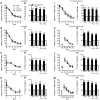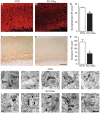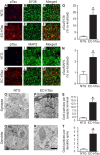Human P301L-mutant tau expression in mouse entorhinal-hippocampal network causes tau aggregation and presynaptic pathology but no cognitive deficits
- PMID: 23029293
- PMCID: PMC3454317
- DOI: 10.1371/journal.pone.0045881
Human P301L-mutant tau expression in mouse entorhinal-hippocampal network causes tau aggregation and presynaptic pathology but no cognitive deficits
Abstract
Accumulation of hyperphosphorylated tau in the entorhinal cortex (EC) is one of the earliest pathological hallmarks in patients with Alzheimer's disease (AD). It can occur before significant Aβ deposition and appears to "spread" into anatomically connected brain regions. To determine whether this early-stage pathology is sufficient to cause disease progression and cognitive decline in experimental models, we overexpressed mutant human tau (hTauP301L) predominantly in layer II/III neurons of the mouse EC. Cognitive functions remained normal in mice at 4, 8, 12 and 16 months of age, despite early and extensive tau accumulation in the EC. Perforant path (PP) axon terminals within the dentate gyrus (DG) contained abnormal conformations of tau even in young EC-hTau mice, and phosphorylated tau increased with age in both the EC and PP. In old mice, ultrastructural alterations in presynaptic terminals were observed at PP-to-granule cell synapses. Phosphorylated tau was more abundant in presynaptic than postsynaptic elements. Human and pathological tau was also detected within hippocampal neurons of this mouse model. Thus, hTauP301L accumulation predominantly in the EC and related presynaptic pathology in hippocampal circuits was not sufficient to cause robust cognitive deficits within the age range analyzed here.
Conflict of interest statement
Figures










References
-
- Bertram L, Lill CM, Tanzi RE (2010) The genetics of Alzheimer disease: back to the future. Neuron 68: 270–281. - PubMed
-
- Hutton M, Lendon CL, Rizzu P, Baker M, Froelich S, et al. (1998) Association of missense and 5′-splice-site mutations in tau with the inherited dementia FTDP-17. Nature 393: 702–705. - PubMed
-
- Reed LA, Wszolek ZK, Hutton M (2001) Phenotypic correlations in FTDP-17. Neurobiol Aging 22: 89–107. - PubMed
-
- Lewis J, McGowan E, Rockwood J, Melrose H, Nacharaju P, et al. (2000) Neurofibrillary tangles, amyotrophy and progressive motor disturbance in mice expressing mutant (P301L) tau protein. Nat Genet 25: 402–405. - PubMed
Publication types
MeSH terms
Substances
Grants and funding
- P50 AG023501/AG/NIA NIH HHS/United States
- R01 AG011385/AG/NIA NIH HHS/United States
- P50 AG005131/AG/NIA NIH HHS/United States
- P30 NS065780/NS/NINDS NIH HHS/United States
- AG011385/AG/NIA NIH HHS/United States
- R01 AG018440/AG/NIA NIH HHS/United States
- R37 AG018440/AG/NIA NIH HHS/United States
- AG022074/AG/NIA NIH HHS/United States
- P01 NS044233/NS/NINDS NIH HHS/United States
- AG023501/AG/NIA NIH HHS/United States
- NS065780/NS/NINDS NIH HHS/United States
- NS044233/NS/NINDS NIH HHS/United States
- R37 AG011385/AG/NIA NIH HHS/United States
- AG5131/AG/NIA NIH HHS/United States
- AG18440/AG/NIA NIH HHS/United States
- P01 AG022074/AG/NIA NIH HHS/United States
LinkOut - more resources
Full Text Sources
Other Literature Sources
Molecular Biology Databases
Miscellaneous

